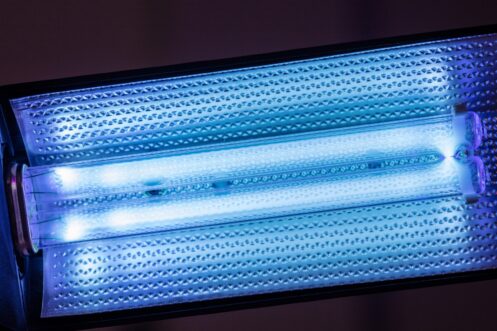Shine Bright: Can UV Lights Clean My Air Ducts and Vents?

The use of UV light as a cleaning mechanism has risen in popularity since the early 20th century. In 1903, Niels Ryberg Finsen received the Nobel Prize in Medicine for his work demonstrating that UV light treatment can have beneficial health effects. Since then, the use of UV light for cleaning has become widespread in hospitals, restaurants, and stores. Given the effectiveness of UV light for commercial buildings, it is understandable that many homeowners would like to use this technology to clean various components of their household HVAC systems. A look at the characteristics of a UV light system can provide insight on whether this solution can improve indoor air quality.
What Is UV Light?
Ultraviolet (UV) light is a type of electromagnetic radiation with wavelengths shorter than visible light. UV light is naturally present in the sun, and scientists later learned to harness the power of UV light to disinfect nonporous surfaces, water, and air. There are three types of UV light:
- UVA (also known as long-wave UV light)
- UVB (also known as medium-wave UV light)
- UVC (also known as short-wave or germicidal UV light)
Of the three types, UVA has the longest wavelength and is the most abundant form of UV rays that reaches the earth from the sun. In contrast, UVC light has the shortest wavelength. Because most UVC light from the sun gets absorbed in the ozone layer and does not reach the earth’s surface, many microorganisms evolved in its absence. Because of this, UVC light can be an effective way to eradicate germs, allergens, and bacteria.
UVC light hinders the ability of microorganisms to produce the proteins necessary for survival. While UVC lights may not kill all germs immediately, the UVC rays can damage their cells enough to shorten their lifespan and eventually reduce or eliminate the population.
How Do UV Lights Work for the Home?
Most HVAC UV lights incorporate UVC rays for their germicidal properties. The idea is that the intensity of UVC rays can help deactivate bacteria, mold, and other airborne pathogens by destroying the nucleic acids of their cells. This renders the DNA unable to replicate and eventually reduces the presence of these contaminants.
Some scientific studies support the effectiveness of using UV light to clean or disinfect indoor spaces. For example, a study at the Duke University Medical Center found that UV light nearly eliminated drug-resistant bacteria in 50 hospital rooms. In the study, the use of UV light reduced the number of bacteria by more than 97%. A similar study at the Columbia University Irving Medical Center found that UVC light can reduce the presence of seasonal airborne pathogens.
While there are undeniable benefits in using UV light to disinfect places like hospitals, there are also practical implications within the home as well. There are two main categories of UV lights for HVAC systems:
Coil Sanitizing Lights
Coil sanitizing lights sit directly above AC coils to help prevent moisture buildup. Because of exposure to condensation, your coils and drain pan can become a moist breeding ground for mold and bacteria. Other debris like dust or pet dander can also accumulate in this area. Coil sanitizing lights are usually shaped like thin tubes and help eradicate contaminants in these spaces. They are the most common types of HVAC UV lighting.
Air Sanitizing Lights
Air sanitizing lights go inside the ductwork of your HVAC system. HVAC professionals usually install these lights into the supply vents that blow air into each room. The purpose of air sanitizing lights is to purify the air before it circulates through the home. Because of the technique involved, it is very important to contact an expert to install lighting instead of attempting to alter your HVAC system by yourself.
Why Should I Clean Air Ducts and Vents?
Air ducts and air vents both play vital roles within the home. Ducts are responsible for circulating and delivering conditioned air throughout the house. These ducts are often composed of sheet metal or similar material strong enough to withstand the force and pressures of airflow. The nonporous composition of sheet metal makes it a perfect candidate for UV light sanitation.
Air vents are openings through which the HVAC system disperses conditioned air into a room. There are two main types of air vents: supply vents and return vents. Supply vents blow air into each of your rooms and are often located high on walls or near the ceiling for maximal comfort. Return vents remove excess air from rooms and send the air back to your HVAC system. They are usually bigger than supply vents, and you will not feel any air blowing from them since the purpose is to regulate air pressure within a room. If requested, HVAC professionals typically install UV lights in the supply vents to purify air distributed within a room.
All ducts and vents need routine maintenance, and most households can benefit from regular ductwork cleaning. For example, types of households that can benefit from special ductwork sanitation include the following:
- Households with occupants that suffer from allergies or asthma
- Households supporting children or elderly
- Households with pets
- Homes exposed to cigarette or cigar smoke
- Homes exposed to water contamination
- Houses with recent renovation or remodeling projects
- Older homes with worn-out vents or ducts
Benefits of UV Lights for Air Ducts and Vents
UV lights offer a direct solution for cleaning ducts and vents. The antimicrobial nature of UVC lights means that most households can benefit when a professional installs this lighting into an HVAC system. A look at some of the top benefits can help you make the right decision for your home.
Improve Indoor Air Quality
Experts estimate that air fully recirculates through an HVAC system an average of five to seven times per day. Over time, this re-circulation can cause an accumulation of existing contaminants within the ducts and along the vents. UV lights help eliminate this buildup and can lower the chances of harmful particles reentering your living space. The best UV lights can help kill off biological pollutants like mold, mildew, algae, fungi, germs, bacteria, and pathogens before they can harm your family.
Improve Energy Efficiency
According to the U.S. Department of Energy, the average home can lose up to 40% of its potential energy. This loss often comes from drafts, air leaks around openings, or dirty heating and cooling systems. UV light can help eliminate the contaminants that accumulate and impede airflow. This means that your system does not have to work as hard to circulate air, and your system operates more efficiently as a result.
Eliminates Awful Odors
Ducts and vents that are contaminated with bacteria, mildew, or mold can emit awful odors. When odors come from the ductwork, methods like opening windows or turning on fans are unlikely to help. UV lights work to kill odor-causing bacteria so that you can enjoy fresh air again.
Are UV Lights Safe?
The use of UV light is safe as long as you reach out to a trained professional for proper handling and installation. Attempting to install UV lights yourself can damage your HVAC system or improperly expose your eyes to UV rays. A professional has the right training that includes using the correct spectrum of ultraviolet light and installing the lights according to industry standards. The expert also has the right equipment to install UV lights properly so that no ultraviolet rays will ever reach a home occupant’s eyes.
Contact Us Today
UV lights offer an effective way to sterilize ducts and vents. If you are interested in HVAC UV lighting, it is important to reach out to a professional for correct installation. Hoff Heating & AC offers UV light and germicidal light installation for homes in O’Fallon, MO and the surrounding areas. Contact Hoff Heating & AC today to upgrade your HVAC system.

